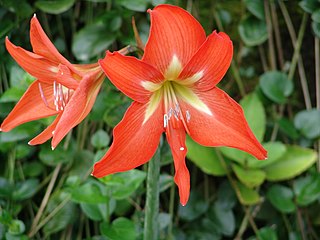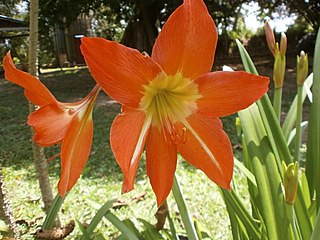
Amaryllis is the only genus in the subtribe Amaryllidinae. It is a small genus of flowering bulbs, with two species. The better known of the two, Amaryllis belladonna, is a native of the Western Cape region of South Africa, particularly the rocky southwest area between the Olifants River Valley and Knysna.

Hippeastrum is a genus of about 90 species, and over 600 hybrids and cultivars, of perennial, herbaceous and bulbous plants, native to tropical and subtropical regions of the Americas, from Mexico south to Argentina and on some islands in the Caribbean. The majority have large, fleshy bulbs—usually about the size of a softball—and tall, broad, strap-like leaves that are (generally) evergreen, and large red or purple flowers. Numerous colors and cultivars have been created over the past hundred years.
Hamilton Paul Traub was an American botanist. He specialized in the study of Amaryllidaceae. He also did horticultural studies on beans. Dr Traub was one of the founding members of the American Amaryllis Society in 1933, and for a long time the editor of its annual publication, variously called Year Book, American Amaryllis Society, Herbertia and Plant Life: Amaryllis Year Book.

Worsleya is a genus of Brazilian plants in the amaryllis family Amaryllidaceae, cultivated as an ornamental because of its showy flowers. There is only one known species, Worsleya procera, native to eastern Brazil. It is endemic to the marshy top of a mesa called "Mount Cuca" 30 miles (52 km) north of Rio de Janeiro. Here the sickle-shaped leaves curve northward. When grown in the northern hemisphere, the leaves curve southward. It is one of the largest and also rarest members of the subfamily Amaryllidoideae.

Rhodophiala was a genus of herbaceous, perennial and bulbous plants in the Amaryllis family. It consisted of about 30 South American species distributed in southern Brazil, Argentina, and, specially, in Chile. Most of the species are known colloquially as añañuca. It has now been submerged in Zephyranthes.

Hippeastrum aulicum, the Lily of the Palace, is a bulbous perennial, in the family Amaryllidaceae, native to the Atlantic Forest and Cerrado ecoregions from Brazil to Paraguay, in South America.

Hippeastrum calyptratum is a flowering perennial herbaceous bulbous plant, in the family Amaryllidaceae, native to Brazil.

Hippeastrum cybister is a flowering perennial herbaceous bulbous plant, in the family Amaryllidaceae, native from Bolivia to Argentina.

Hippeastrum ferreyrae is a flowering perennial herbaceous bulbous plant, in the family Amaryllidaceae, native to Peru.

Hippeastrum papilio is a flowering perennial herbaceous bulbous plant, in the family Amaryllidaceae, native to southern Brasil.

Phycella is a genus of herbaceous, perennial bulbous flowering plants belonging to the family Amaryllidaceae, subfamily Amaryllidoideae. The genus consists of five species distributed from central Chile to northwestern Argentina.

Hippeastrum pardinum is a flowering perennial herbaceous bulbous plant, in the family Amaryllidaceae, from Peru to Bolivia. Originally collected in 1866 by Richard Pearce, it was used in breeding programmes.
Hippeastrum petiolatum is a flowering perennial herbaceous bulbous plant, in the family Amaryllidaceae, distributed from Paraguay to Uruguay and Argentina.

Hippeastrum psittacinum is a flowering perennial herbaceous bulbous plant, in the family Amaryllidaceae, native to Brazil.

Hippeastrum reginae is a flowering perennial herbaceous bulbous plant, in the family Amaryllidaceae, native to Venezuela, Bolivia, Peru and Brazil.

Hippeastrum striatum, the striped Barbados lily, a flowering perennial herbaceous bulbous plant, in the family Amaryllidaceae, native to the southern and eastern regions of Brazil.

Hippeastrum mirum is a species of herbaceous perennial bulbous flowering plants in the amaryllis family, Amaryllidaceae, subfamily Amaryllidoideae. It was formerly treated as Tocantinia mira.

Hippeastrum reticulatum, the netted-veined amaryllis, is a flowering perennial herbaceous bulbous plant, in the family Amaryllidaceae, native to South America.




















